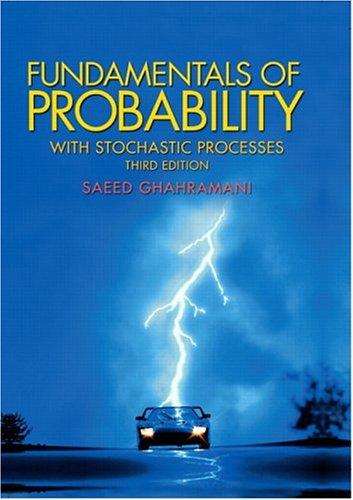44. (Laplaces Law of Succession) Suppose that n + 1 urns are numbered 0 through n, and...
Question:
44. (Laplace’s Law of Succession) Suppose that n + 1 urns are numbered 0 through n, and the ith urn contains i red and n − i white balls, 0 ≤ i ≤ n. An urn is selected at random, and then the balls it contains are removed one by one, at random, and with replacement. If the first m balls are all red, what is the probability that the (m + 1)st ball is also red? Hint: Let Ui be the event that the ith urn is selected, Rm the event that the first m balls drawn are all red, and R the event that the (m + 1)st ball drawn is red. Note that R and Rm are conditionally independent given Ui; that is, given that the ith urn is selected, R and Rm are independent. Hence P (R | RmUi) = P (R | Ui) = i n . To find P (R | Rm), use P (R | Rm) = .n i=0 P (R | RmUi)P (Ui | Rm), where P (Ui | Rm) is obtained from Bayes’ theorem. The final answer is P (R | Rm) = .n i=0 * i n ,m+1 .n k=0 *k n ,m . Note that if we consider the function f (x) = xm+1 on the interval [0, 1], the right Riemann sum of this function on the partition 0 = x0 < x1 < x2 < ··· < xn = 1, xi = i/n is .n i=1 f (xi)(xi − xi−1) = .n i=1 xm+1 i 1 n = 1 n .n i=0 * i n ,m+1 . Therefore, for large n,(1/n)/n i=0(i/n)m+1 is approximately equal to # 1 0 xm+1dx = 1/(m+2). Similarly, (1/n)/n k=0(k/n)m is approximately # 1 0 xmdx = 1/(m+1). Hence P (R | Rm) = 1 n .n i=0 * i n ,m+1 1 n .n k=0 *k n ,m ≈ 1/(m + 2) 1/(m + 1) = m + 1 m + 2 . Laplace designed and solved this problem for philosophical reasons. He used it to argue that the sun will rise tomorrow with probability (m+1)/(m+2) if we know that it has risen in the m preceding days. Therefore, according to this, as time passes by, the probability that the sun rises again becomes higher, and the event of the sun rising becomes more and more certain day after day. It is clear that, to argue this way, we should accept the problematic assumption that the phenomenon of the sun rising is “random,” and the model of this problem is identical to its random behavior.
Step by Step Answer:

Fundamentals Of Probability With Stochastic Processes
ISBN: 9780131453401
3rd Edition
Authors: Saeed Ghahramani






